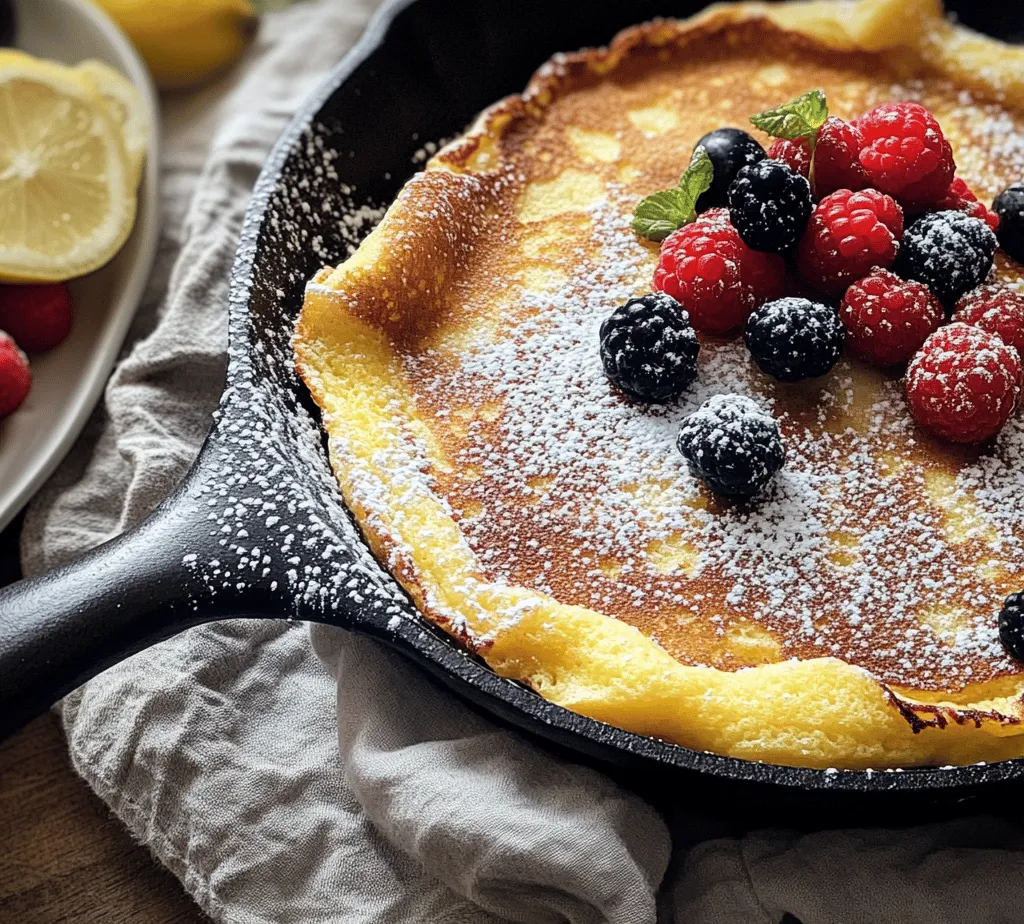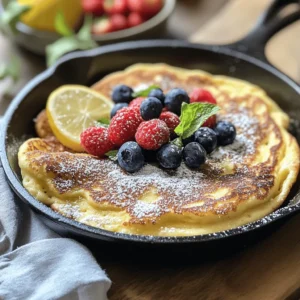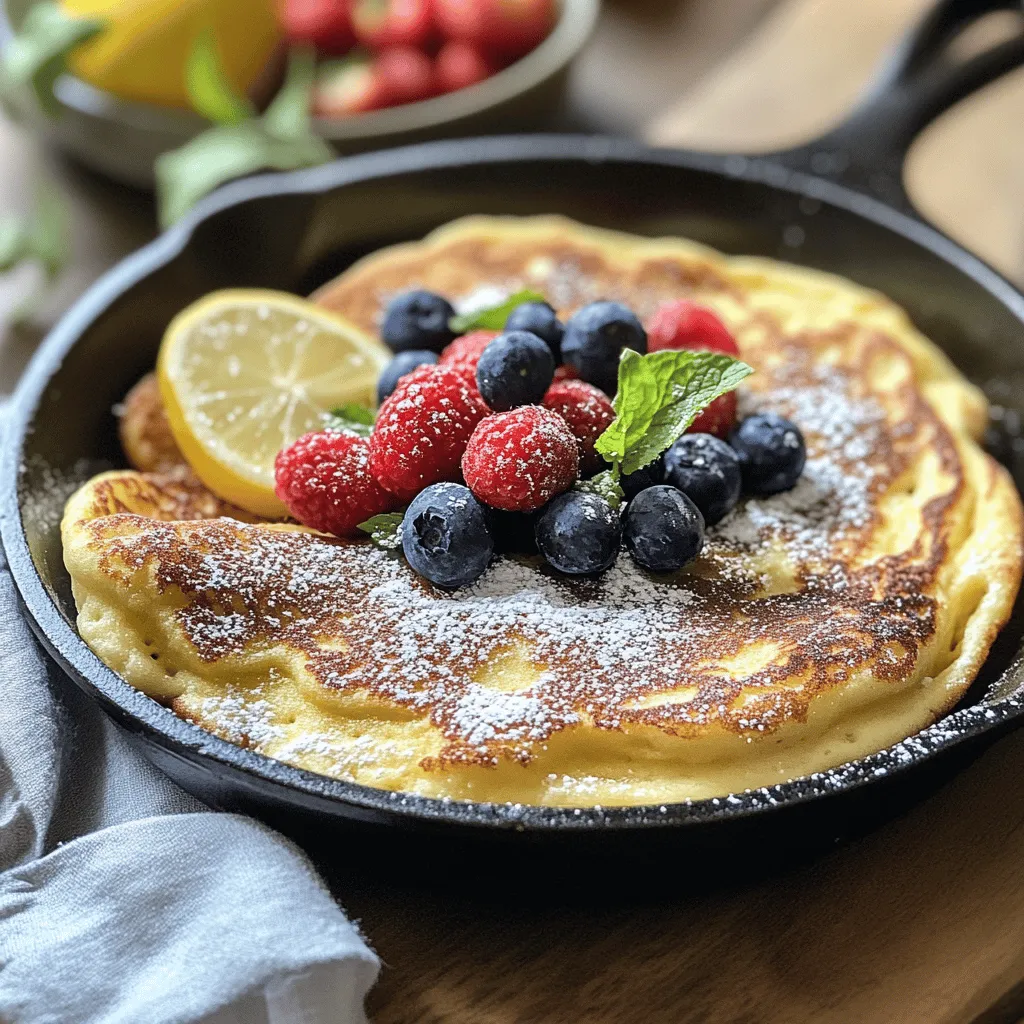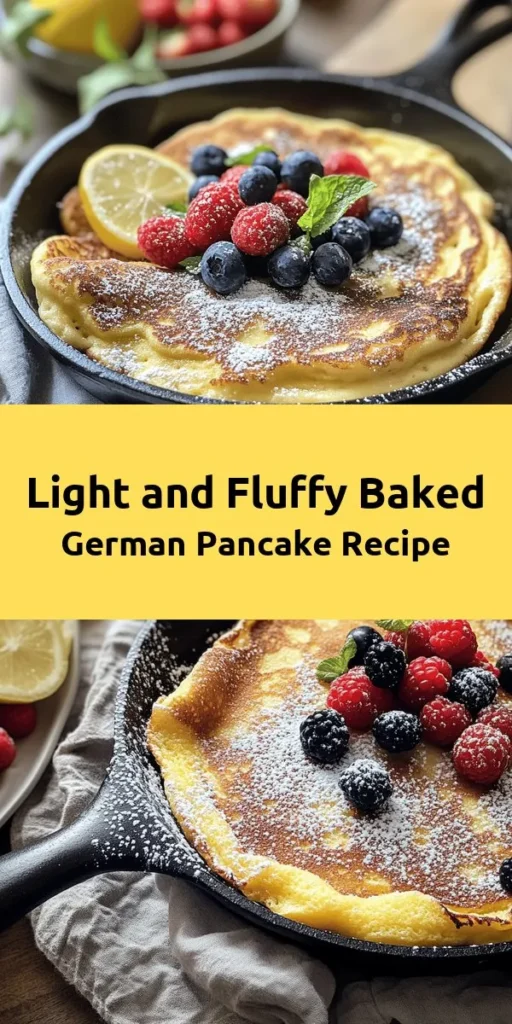Introduction
Breakfast is often hailed as the most important meal of the day, and for good reason. It sets the tone for our energy levels and mood, and serves as a delightful opportunity to indulge in delicious creations. One remarkable breakfast item that has captured the hearts (and taste buds) of many is the German pancake, also known as a Dutch baby pancake. This delectable dish has gained immense popularity in breakfast culture, not only for its unique presentation but also for its fluffy texture and ease of preparation.
The Baked German Pancake is a true showstopper. Unlike traditional pancakes that you cook one by one on a griddle, this pancake is baked in the oven, allowing it to puff up dramatically. The result is a golden, airy confection that can be served straight from the oven, making it a perfect choice for brunch gatherings or cozy family breakfasts. Its versatility is another of its charms; you can easily customize it with various toppings, from sweet to savory, appealing to a wide range of palates.
Whether you’re a novice cook or an experienced chef, this recipe is accessible and straightforward. With just a few ingredients and minimal effort, you can present a stunning pancake that’s sure to impress, making it a staple in households around the world.
Understanding the Baked German Pancake
So, what exactly is a German pancake, and how does it differ from the traditional pancakes we might be accustomed to? At first glance, the German pancake may resemble a custard or a popover, but its taste and texture set it apart. The key characteristic of a German pancake is its incredible fluffiness. When baked, it rises spectacularly, creating a light and airy structure that is both satisfying and indulgent.
Originating from Germany, this dish has evolved over time and crossed borders, becoming a beloved breakfast item in various cultures. While the exact origins are somewhat nebulous, it’s widely believed that German pancakes were brought to the United States by German immigrants in the 19th century. Over the years, it has adopted various names and interpretations, including the famous “Dutch baby” in America, which is not Dutch at all but rather a nod to the Pennsylvania Dutch.
The science behind the pancake’s puffiness is fascinating and lies primarily in its main ingredients—eggs and high heat. When you beat the eggs and combine them with milk, flour, and other ingredients, they create a batter that traps air bubbles. As the batter is exposed to high heat in the oven, these air pockets expand, causing the pancake to rise dramatically. This unique baking method results in a texture that is both soft and tender with crisp edges, making it a delightful dish to savor.
Ingredients Breakdown
To craft the perfect Baked German Pancake, understanding the role of each ingredient is crucial. Here’s a breakdown of what you’ll need for this recipe and why each component is essential:
– Eggs: Eggs are the backbone of this recipe. They provide structure and stability, allowing the pancake to rise beautifully. They also contribute to the pancake’s rich flavor and custardy texture. When whisked, eggs help to incorporate air, which is key for achieving that fluffy finish.
– Whole Milk: Whole milk adds richness and moisture to the batter. The fat content in whole milk contributes to a tender pancake, enhancing both flavor and texture. If you’re looking to make it even creamier, you might consider using half-and-half or even cream, though this will adjust the overall richness of the dish.
– All-Purpose Flour: The flour acts as the backbone of the recipe, providing the necessary structure to hold the pancake together. All-purpose flour is ideal because it has a moderate protein content, which helps achieve a balance between tenderness and strength.
– Granulated Sugar: Just a touch of sugar is essential for balancing the flavors. It not only adds sweetness but also enhances browning during baking, resulting in a beautiful golden color. The sugar helps to create a slight caramelization on the edges, adding to the overall appeal.
– Salt: A pinch of salt is crucial in any recipe as it enhances the flavors of the other ingredients. In the case of the German pancake, it balances the sweetness and elevates the overall taste, making every bite more enjoyable.
– Vanilla Extract: Adding a splash of vanilla extract introduces depth and aroma to the pancake. It complements the other flavors beautifully and makes the dish feel even more special.
– Unsalted Butter: Butter is a vital ingredient that contributes a rich flavor and moistness to the pancake. When melted and poured into the baking dish, it creates a luscious base that helps the edges crisp up while keeping the center soft and fluffy.
– Fresh Lemon Juice and Powdered Sugar: These traditional serving suggestions not only brighten the flavor of the pancake but also add a lovely tartness that contrasts beautifully with the sweetness. A dusting of powdered sugar on top offers a final touch of sweetness and an appealing presentation.
– Fresh Berries or Fruit: Optional toppings like fresh berries or slices of your favorite fruit not only enhance the aesthetic appeal but also add nutritional value. The natural sweetness and acidity of fruits like strawberries, blueberries, or even bananas elevate the dish, making it a well-rounded breakfast option.
By understanding each ingredient’s purpose, you can appreciate how they come together to create the fluffy, delightful experience that is the Baked German Pancake. Now that we’ve covered the essential components, let’s dive into the preparation steps that will transform these ingredients into a delicious breakfast masterpiece.
Stay tuned for the next section, where we will explore the step-by-step instructions to bring this delectable dish to life!

Step-by-Step Instructions for Perfecting Your Baked German Pancake
Preheating the Oven: Importance of Temperature for Puffiness
To achieve that iconic puffiness characteristic of a Baked German Pancake, preheating your oven is crucial. Set your oven to 425°F (220°C) and allow it to reach this temperature before placing your skillet inside. The hot oven creates steam, which is essential for the pancake to rise and puff up beautifully. If the oven isn’t hot enough, your pancake may end up dense and flat instead of light and airy.
Preparing the Batter: Tips for Achieving a Lump-Free Mixture
As you prepare your batter, it’s important to ensure it is smooth and lump-free. To do this, start by mixing the eggs, milk, and flour in a large mixing bowl. Whisk the eggs thoroughly before adding the milk, then gradually sift in the flour. This technique helps to eliminate clumps. If you find lumps despite your best efforts, using an immersion blender or a regular blender can help you achieve a velvety consistency. Blend just until combined; overmixing can lead to a tougher pancake.
Using a Cast-Iron Skillet: Benefits for Even Cooking and Heat Retention
A cast-iron skillet is the secret weapon for crafting the perfect Baked German Pancake. Its ability to retain and distribute heat evenly ensures that your pancake cooks uniformly. Before you pour in your batter, place the skillet in the preheating oven for about 5-10 minutes. This step not only preheats the skillet but also creates a non-stick surface when you add butter. The result is a pancake that rises beautifully with a crispy edge.
Pouring the Batter into the Skillet: Timing and Technique for Best Results
Once your oven and skillet are preheated, carefully remove the skillet using oven mitts. Add a generous tablespoon of unsalted butter, swirling it around until melted and foamy. Pour the batter into the skillet immediately after adding the butter. The batter should sizzle as it hits the hot skillet, which helps to create that irresistible crispy edge. Timing is key here; if you wait too long, the skillet will lose heat, impacting the pancake’s rise.
Baking: How to Know When the Pancake is Done and Achieving the Perfect Golden-Brown Finish
Bake your pancake for 20-25 minutes, without opening the oven door during the first 15 minutes to maintain the heat. The pancake is done when it has puffed up and turned a beautiful golden-brown color. You can test for doneness by inserting a toothpick into the center; it should come out clean or with a few moist crumbs. If the edges are slightly crispy and the center has a gentle jiggle, you’re in for a treat.
Cooling and Serving: Expectations on Deflation and Presentation Tips
After removing the pancake from the oven, let it cool for a few minutes. Expect some deflation during this time—it’s normal for a Baked German Pancake. To serve, cut it into wedges or slices directly in the skillet, or gently transfer it to a serving platter for a more elegant presentation. Dust with powdered sugar for a classic touch and serve with lemon wedges on the side, allowing guests to squeeze fresh juice over their slices for that delightful tartness.
Serving Suggestions and Pairings
Traditional Serving Recommendations: Lemon Juice and Powdered Sugar
The traditional way to serve a Baked German Pancake is simple yet effective. A generous sprinkle of powdered sugar and a squeeze of fresh lemon juice create a perfect balance of sweetness and tartness. This classic combination enhances the pancake’s flavor, making each bite refreshing.
Creative Topping Ideas:
– Various Fruits and Their Flavor Profiles: Fresh fruits are an excellent way to elevate your pancake experience. Consider topping your pancake with berries like strawberries, blueberries, or raspberries for a burst of sweetness. Sliced bananas add a creamy texture, while tart apples or pears can provide a nice crunch.
– Other Sweet Options Like Maple Syrup or Honey: For those with a sweet tooth, drizzle some pure maple syrup or honey over your warm pancake. These sweeteners add a delightful richness that complements the pancake’s flavor.
– Savory Variations and Sides (e.g., Bacon, Sausages) for a Complete Meal: If you prefer a savory twist, consider serving your Baked German Pancake alongside crispy bacon or sausages. The salty flavors create a satisfying contrast to the sweetness of the pancake, making it a perfect brunch option.
Nutritional Information
Overview of the Nutritional Content of the Baked German Pancake
A standard serving of Baked German Pancake (about one wedge) typically contains around 180-220 calories, depending on portion size and toppings. It also provides protein from the eggs and some carbohydrates from the flour. However, the nutritional content can vary based on the specific ingredients used and any additional toppings.
Discussion of Portion Sizes and How to Modify the Recipe for Dietary Preferences
For those watching their caloric intake, consider cutting the pancake into smaller wedges or pairing it with a side of fresh fruit to maintain satisfaction without overindulgence. If you have dietary restrictions, the recipe can be easily modified. For a gluten-free version, substitute regular flour with a gluten-free flour blend. Similarly, using almond milk or soy milk in place of cow’s milk can cater to those with dairy sensitivities.
Balancing Indulgence with Nutrition: Tips for Enjoying This Treat in Moderation
While Baked German Pancakes are a delightful treat, enjoying them in moderation is essential. Pairing with fresh fruit not only adds flavor but also increases the nutritional value, providing vitamins and fiber. If you’re serving this dish for breakfast, consider incorporating a side of protein—like eggs or Greek yogurt—to balance the meal and keep you full longer.
Conclusion
Making and sharing a Baked German Pancake is a joyful experience that brings people together around the breakfast table. Its delightful puffiness and versatility as a dish suitable for breakfast, brunch, or even dessert make it a beloved recipe in many households.
Encouraging your creativity with toppings allows you to personalize this dish, whether you stick to traditional lemon and powdered sugar or venture into more adventurous territories with fruits and savory sides. Each time you make this recipe, you can evoke the comforting charm of traditional German cuisine while adding your unique twist. So gather your ingredients, preheat your oven, and enjoy the process of crafting your own Fluffy Dutch Delights!



